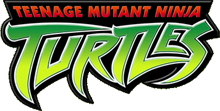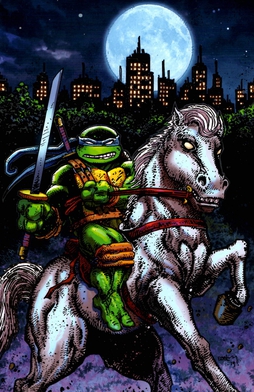
Leonardo, commonly nicknamed Leo, is a superhero appearing in Teenage Mutant Ninja Turtles comics and related media, and created by American comic book artists Kevin Eastman and Peter Laird. He is one of the four central characters of the franchise, along with his brothers, Raphael, Donatello, and Michelangelo. Leonardo is the oldest turtle and the fearless leader of the group.

The Shredder is a supervillain and the main antagonist of the Teenage Mutant Ninja Turtles media franchise created by Kevin Eastman and Peter Laird. The character debuted in the Mirage Studios comic book Teenage Mutant Ninja Turtles #1, and has since endured as the archenemy of the turtles and their Master Splinter.
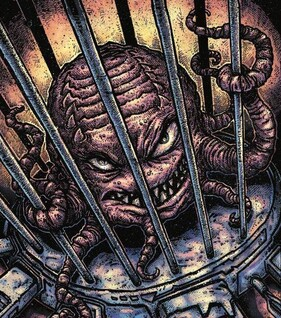
Krang is a supervillain appearing in Teenage Mutant Ninja Turtles-related media, most frequently in the 1987 animated series and its associated merchandise, such as the Teenage Mutant Ninja Turtles Adventures comic book and many TMNT video games. The character has endured as one of the franchise's most prominent antagonists and a major foe of the Ninja Turtles.

Splinter, often referred to as Master Splinter or Sensei by his students/sons, is a fictional character from Teenage Mutant Ninja Turtles comics and all related media. A mutant rat, he is the grave and stoic sage of the Turtles, their ninjutsu and martial arts instructor, and their adoptive father. The character was originally a parody of the Marvel Comics character Stick.

The Foot Clan is a fictional ninja clan in the Teenage Mutant Ninja Turtles comics and all related media and are the main antagonists. It is led by the devious Shredder and his second in command Karai. The Foot Clan was originally a parody of the criminal ninja clan The Hand in the Daredevil comics. In addition to the obvious similarity in their names, both clans originate from Feudal Japan, practice ninjutsu and black magic, and are now powerful global organized crime rings who are familiar with multiple illegal activities such as drug smuggling, counterfeiting of money, gunrunning, murder, assassination, computer hacking, theft, and terrorism.
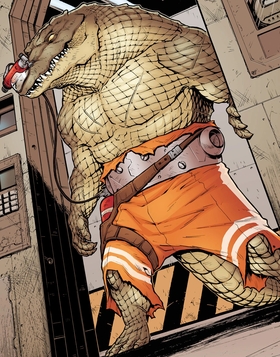
Leatherhead is a fictional character in the Teenage Mutant Ninja Turtles (TMNT) comics and all related media. The character first appeared in Tales of the Teenage Mutant Ninja Turtles #6 and was created by Ryan Brown. He is depicted as a mutated humanoid-alligator.

Karai is a fictional supporting character appearing in Teenage Mutant Ninja Turtles comics and related media. She is usually a high-rank member of the Foot Clan outlaw ninja organization. She was originally introduced in Kevin Eastman and Peter Laird's comic book series Teenage Mutant Ninja Turtles in 1992. Since then, she has appeared in several different Teenage Mutant Ninja Turtles comics, television series, films, and video games. She is depicted as Shredder's second-in-command or adopted daughter in most versions and shares a rivalry with Leonardo and is at times considered his love interest. In one version of the comics, she is the granddaughter of the immortal Shredder, while in the 2012 series, she is Hamato Miwa, the only child of Hamato "Splinter" Yoshi and the late Tang Shen.

Teenage Mutant Ninja Turtles 2: Battle Nexus is a third person beat 'em up video game, released in 2004 by Konami. It is the sequel to Teenage Mutant Ninja Turtles and is based on the 2003 TV series.
The first season of Teenage Mutant Ninja Turtles originally aired between February 8, 2003 and November 1, 2003, beginning with the pilot episode "Things Change". The episodes were first released in eight volumes, TMNT Volume one through Volume eight. The volumes were released from September 2, 2003 through March 16, 2004. The episodes were later released in 2 part season sets, part 1 was released on May 22, 2007 which had the first 12 episodes, and part 2 was released on September 18, 2007, which had the final 14 episodes of the season.
The second season of Teenage Mutant Ninja Turtles originally aired between November 8, 2003 and October 2, 2004, beginning with the "Turtles in Space, Part 1: The Fugitoid" episode. The episodes were first released on DVD in eight volumes, TMNT Volume nine through Volume fourteen. The volumes were released From May 18, 2004 through January 18, 2005. The episodes were later released in 2 part season sets; part 1 was released on February 19, 2008, containing the first 12 episodes of the season, and part 2 was released on October 28, 2008 with the final 14 episodes.
The Ninja Tribunal arc was the fifth season of the 2003 Teenage Mutant Ninja Turtles animated series.
The third season of Teenage Mutant Ninja Turtles originally aired between October 9, 2004, and April 23, 2005, beginning with the "Space Invaders, Part 1" episode. The entire season of the television series was released on DVD in seven volumes from March 15, 2005, through May 16, 2006. This is the only season of the 2003 series which has a prodcode, and included a Christmas episode under the title "The Christmas Aliens".
The fourth season of Teenage Mutant Ninja Turtles originally aired between September 10, 2005 and April 15, 2006, beginning with the "Cousin Sid" episode. Fourteen random episodes from this season were released on DVD on September 12, 2006. Much of this season focused on Leonardo, the group's leader, who became bitter, reserved and isolated following the final episode of the previous season in which he, his brothers and their master were almost killed. He went so far as to lash out at Splinter, causing him serious injury. This season is known among of fans as the darkest season of the series.
The sixth season originally aired between July 29, 2006, and October 27, 2007, beginning with the "Future Shellshock" episode. The season is lighter in tone and less violent than previous ones, with a greater emphasis on jokes, and includes recreated designs for all returning characters.
The seventh and final season of Teenage Mutant Ninja Turtles, titled Back to the Sewer or TMNT: Back to the Sewer, aired on Saturday mornings on the CW4Kids on CW Network in 2008–2010. With this season, the show moved from Fox's 4Kids TV lineup to the CW. The season began with the episode "Tempus Fugit" which aired on September 13, 2008. It is followed by the TV movie Turtles Forever.

Turtles Forever is a 2009 American animated superhero television film directed by Roy Burdine and Lloyd Goldfine and written by Goldfine, Rob David, and Matthew Drdek. A crossover film featuring two different incarnations of the Teenage Mutant Ninja Turtles fighting together, it was produced in celebration of the 25th anniversary of the characters and serves as the finale to the 2003 TV series. The film aired on The CW4Kids on November 21, 2009.
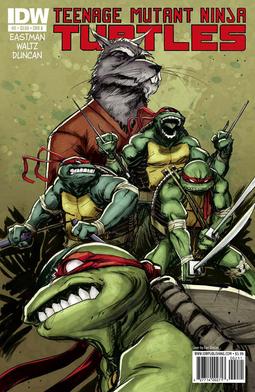
Teenage Mutant Ninja Turtles is an ongoing American comic book series published by IDW Publishing. Debuting in August 2011, the series is part of the Teenage Mutant Ninja Turtles media franchise created by Kevin Eastman and Peter Laird and was the first new comic incarnation of the Turtles to debut after the franchise's sale to Nickelodeon in October 2009. It is the fifth comic book series in the franchise's publication history and serves as a reboot of the franchise's story and characters.
